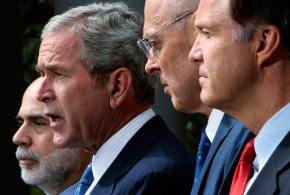Fumbling for solutions
explains why the Group of Seven industrialized countries failed to come up with a coordinated plan to rescue the world economy.
THE BIG industrial powers went into the weekend promising an internationally coordinated economic rescue plan--but then announced competing measures instead.
After finance ministers of the Group of Seven industrial powers met in Washington, the heads of the European Union announced a plan to guarantee loans between banks and a program for national governments to invest directly in them. These efforts, which follow government guarantees of bank deposits, are aimed at reviving inter-bank lending and reassuring the banks' depositors and investors.
The problem is what the financial press calls a credit crisis. The banks are so unconfident in their own solvency and that of other financial institutions that they won't lend to each other, much less to business or individuals, because they fear more failures and bankruptcies are waiting to happen.
"It is now virtually impossible for any institution to finance itself in the markets longer than overnight," an editorial in the Financial Times summarized. "This is a measure of the panic-stricken collapse in confidence that has seized the system...Only if every significant country acts in parallel, with measures that are mutually supportive, will they be able to halt the crisis."

For its part, the U.S. stumbled along behind the Europeans, with Treasury Secretary Henry Paulson suggesting that the federal government will make direct government investments in the banks. When Congress considered the Bush administration's $700 billion bailout for Wall Street, Paulson bitterly resisted efforts to include authority for direct investments in banks. But that opposition has fallen by the wayside.
These would be the latest in a series of U.S. government investments in financial institutions. Already, the U.S. has taken over the huge mortgage companies Fannie Mae and Freddie Mac and the world's largest insurance company AIG.
The staunchly free-market Bush administration is spending its last weeks in office carrying through the greatest government intervention in the economy since the New Deal during the Great Depression of the 1930s. The old mantras of pro-business, neoliberal economic policy have been tossed overboard--and by Paulson, a former top Wall Street executive, no less.
DETAILS OF the latest Paulson plan were to be announced when the financial markets opened today. The question, however, is whether he will have any credibility.
A few weeks ago, Paulson was portrayed as the man on a white horse, riding to the rescue of the economy, willing to take bold and unorthodox measures to stem the crisis. Now he's increasingly seen as an incompetent clown who botched government attempts to gain control of the situation--the latest bumbler in a long line of self-interested and inept Bush administration officials.
Ever since the crisis broke more than a year ago, Paulson, a former CEO of the dominant Wall Street investment bank Goldman Sachs, had assured the world that the crisis would be "contained"--even, in fact, after he intervened to force the sale of investment bank Bear Stearns to JPMorgan Chase last March.
On July 20, Paulson told the Associated Press, "It's a safe banking system, a sound banking system. Our regulators are on top of it. This is a very manageable situation."
Ten days later, Paulson got Congress to authorize him to take control of the huge government-sponsored mortgage giants, Fannie Mae and Freddie Mac, but declared that he'd never have to use that power. Before a month went by, however, Paulson ordered the nationalization of the two companies at a cost of $200 billion. Soon afterward, Paulson nationalized AIG to pre-empt a possible meltdown in credit "derivatives," the complicated financial investments that are heavily linked to bad mortgage debt.
But even as Paulson lurched from his "the-fundamentals-are-sound" line to a series of ad hoc measures, he reverted to his free-market dogma and let the investment bank Lehman Brothers go bust.
This triggered a crisis among financial institutions that traded with Lehman--in particular, the money-market mutual funds that supply loans to the $1.6 trillion commercial paper market. Ordinarily a humdrum operation that allows big corporations to get short-term loans to pay suppliers or make payroll, the commercial paper market has hardly functioned for more than three weeks.
Paulson's erratic and contradictory policies fueled the crisis. Panicked at the result of the Lehman collapse, Paulson demanded that Congress give him $700 billion to buy up the bad debts of financial institutions with taxpayers' money. After the initial rejection of the plan in the House of Representatives, the Democratic-controlled Congress obliged Paulson with the passage of the $700 billion Troubled Assets Relief Program (TARP).
But the international markets have rejected the TARP law. The week that followed its passage was one of the worst in Wall Street's history.
While Paulson began an effort to hire Wall Street professionals to oversee the buying of the banks' toxic assets--that is, put the very people who caused the problem in charge of the "solution"--world stock markets crashed and credit got still tighter.
As the raging waters of the financial crisis kept rising, the treasury secretary confined himself to the economic equivalent of Bush's flyover of Katrina-struck New Orleans. Heck of a job, Henry!
What about that $900 billion of loans made available to the banks by Federal Reserve Chair Ben Bernanke? It's a bit like Homeland Security Secretary Michael Chertoff rattling off the numbers of trailers and fresh water tanker trucks on their way to the post-hurricane Gulf Coast: The aid is simply failing to provide help where it's needed most.
No matter how much money is pumped into the system by the Fed and central banks around the world, banks are refusing to lend to one another. Each is hoarding cash, both to compensate for the bad debts on its own books and to protect itself from a possible failure of other banks it might trade with. Even Bernanke's moves to have the Fed buy commercial paper--in other words, use the central bank's resources to thaw the credit freeze in this market--couldn't end the panic.
As a result, financial stocks of all types got hammered. The investment bank Morgan Stanley was hanging on by a thread as this article was being written, waiting for an investment from a big Japanese bank that reportedly hangs on whether the U.S. government will guarantee any losses. Also, stocks of insurance companies were being dumped, as investors fear more AIG-type debt problems.
Meanwhile, the credit squeeze is suffocating the "real" goods-producing and service economy.
For example, auto sales are plummeting because consumers can't get loans and auto companies have difficulty getting access to credit. General Motors, having explored merger talks with Ford several weeks ago, is now considering a deal with Chrysler--a move that would eliminate tens of thousands of jobs.
Many far more profitable firms are having trouble getting loans and will have to scale back operations and eliminate jobs unless a solution is found. Thus, the credit squeeze threatens to turn a global recession into a depression.
NO ONE knows if the European emergency economic plan--and the latest American one--will stabilize the world stock markets and get credit flowing again in the short term. The U.S. may be compelled to adopt the European plan of guaranteeing inter-bank loans in order to get banks to trade with one another again.
Yet even if these plans have some success in the near term, the recession will nevertheless be deep and long lasting. To revive economic growth, banks around the world must clean up their balance sheets by dumping bad debts--or have it done for them by government officials.
Sooner or later, this will involve a devaluation of assets of all kinds--that is, a financial admission that investments or loans aren't worth what they once were--and this will trigger bankruptcies and rising unemployment. Governments, because they are spending billions in tax revenues to bail out the banks, will make life worse for working people by cutting social spending on education, health care and more.
The problem for big business is how to accomplish this politically. The old neoliberal slogans of free enterprise and personal responsibility don't cut it when multimillionaire bankers have to rush into the protective arms of "Big Government." When articles questioning the viability of capitalism can be found all around the corporate media, it isn't possible to carry on as usual.
Barack Obama's Democrats, poised for a sweeping victory in the November 4 elections, will retool U.S. politics for this new, crisis-ridden era. But while the rhetoric may change, the underlying policies are unlikely to do so. Close by Obama's side these days are two former secretaries of the Treasury, Robert Rubin and Larry Summers. They, along with former Fed chair Alan Greenspan, are architects of the deregulated markets and financial bubbles that brought us to this catastrophe.
It's worth recalling that Greenspan, Rubin and Summers were dubbed the "committee to save the world" during the East Asian financial crisis of 1997. Then, their "rescue" program was to impose, via the International Monetary Fund, a series of austerity measures as a condition for affected countries to receive emergency loans.
The result was a huge increase in joblessness and poverty. In Indonesia, the rural poor resorted to eating tree bark to survive. In Thailand, starving peasant families turned their daughters over to prostitution gangs to ensure that they would be fed.
U.S. policymakers, of course, aren't considering such extreme measures for the American economy. But the basic pattern holds. The government and business will attempt to make workers bear the cost of the crisis, through a transfer of tax dollars into the banks, a decline in real wages, and cutbacks in needed government programs.
The only question is whether working people, angry at a failing and discredited system, will let them get away with it.


